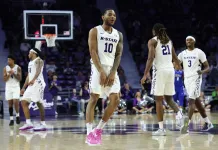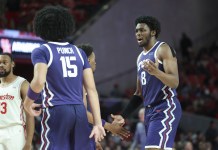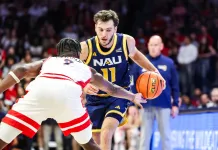Shared Statistical Traits of College Basketball Contenders
In my opinion, the college basketball futures board hasn’t been picked over by the betting public yet because so many are still focused on the Super Bowl markets rather than March Madness. As such, bettors can still find some pretty value now in looking ahead to who could cut down the nets at Phoenix in early April. With that in mind, I’d like to share the method I use to find teams that have championship-level resumes at this point in the season. You will recognize it as the same process I always offer up come tournament time, and it’s called Shared Statistical Traits Analysis.
Before I begin, I would like to “toot my own horn” and tell you that I have done this around New Year’s every year since COVID wiped out the tournament in 2020 and have been able to peg the eventual title winner in all three years. Before anyone starts believing I am Nostradamus or something, I’ll admit that I always pick a group of teams with the highest Shared Traits, and that number has ranged from six to seven teams over the last four years, including Connecticut at this time last year when I recognized the Huskies as one of seven teams I felt was capable of cutting down the nets to close the tournament. That said, UConn was listed at 20-1 when I wrote the piece, so anyone who invested one unit in all seven teams I denoted at the time could still post a 14-unit profit.
Again, the methodology I like to employ I have called “Shared Statistical Traits” to compare current teams to past teams achieving a certain goal or level of success. I am of the belief that while the teams and players might change from year to year, the overall resume of what it takes to be a champion does not.
For this exercise, what I am going to do is take a current snapshot of the key stats, rosters, and strength ratings of the country’s top teams and share which ones have the most traits befitting of a title contender. Essentially, I pick out 12 different key statistical categories and four of my own personal Strength Indicators, plus a Combined Average Ranking. Here they are.
Steve Makinen’s Power Rating
Opponent Power Rating (Schedule Strength)
Offensive Points per Game
Defensive Points per Game
Steve Makinen’s Effective Strength Indicator
Steve Makinen’s Bettors’ Rating
Steve Makinen’s Momentum Ratings
Effective Offensive Points per Possession
Effective Defensive Points per Possession
Offensive Field Goal %
Offensive 3PT Field Goal %
Rebounding Percentage
Assist to Turnover Ratio
Offensive Turnovers per Possession
Defensive Turnovers per Possession
Defensive Field Goal %
Combined Average Ranking
After determining the national season ranks for all the Division 1 college basketball teams, I compared them to the Champion teams from the last 10 tournaments for special analysis. For each stat category, I look for minimum performance, typical national ranking, and the percentile of teams that qualify within certain ranges. As a final exclamation point on the analysis, I take a Combined National Ranking of the 16 sortable categories to separate the more complete teams from the rest.
In the past, when summarizing the findings, I have determined that the relationship between my Effective Strength Indicator was the most significant of all the categories analyzed. The average of the last 40 Final Four teams ranked about 15th in the country in that rating. Among the harder core statistical categories, Effective Defensive Points per Possession was most important. Interestingly, the least important factor was Defensive Turnovers per Possession, or the ability to force turnovers on defense.
Shared Traits of Tournament Champions
Recent years of tournament action have shown that there is a big difference in reaching the Final Four and winning the title. Typically, only the truly elite teams accomplish the latter. Last year that point was exacerbated, with UConn being the only legitimate title-worthy team that landed in Houston. Here’s a look at the minimum requirements for winning a tournament championship over the last decade. Just to jog your memory, these are the nine champions and their seed during that time span:
2013 LOUISVILLE (#1)
2014 CONNECTICUT (#7)
2015 DUKE (#1)
2016 VILLANOVA (#2)
2017 NORTH CAROLINA (#1)
2018 VILLANOVA (#1)
2019 VIRGINIA (#1)
2021 BAYLOR (#1)
2022 KANSAS (#1)
2023 CONNECTICUT (#4)
Looking for clear separations in the teams’ stats/ranks of the last 10 NCAA Champions:
- Nine teams went into the tournament with a Steve Makinen Power Rating of 89 or higher.
- Nine teams finished the regular season with a Schedule Strength ranked in the top 46 nationally.
- Eight teams ranked in the Top 55 in Offensive Points per Game and scored at least 72 PPG.
- Seven teams ranked in the Top 115 in Defensive Points per Game or allowed less than 66 PPG.
- Nine teams had a Steve Makinen Effective Strength Indicator Rating of at least +18.5 and ranked in the Top 7 nationally.
- Nine teams had a Steve Makinen Bettors Rating of at least -15.5 and ranked in the Top 7 nationally.
- Nine teams had a Steve Makinen Momentum Rating ranked in the Top 8 nationally
- Nine teams scored at least 1.185 Effective Points per Possession on offense and ranked in the Top 18 nationally.
- All 10 teams allowed better than 0.97 Effective Points per Possession on defense, and seven of them ranked in the Top 15 nationally.
- Eight teams shot at least 45% from the field on the season, ranking in the Top 45 nationally in FG%.
- Eight teams made at least 34.5% of its 3PT attempts on the season, placing them in the Top 100 of all teams.
- Eight teams had a Rebounding Percentage Rate of at least 52% and ranked in the Top 65 of the country.
- Nine teams had an Assist to Turnover Ratio of at least 1.185, ranking in the Top 55 nationally.
- Seven teams ranked in the country’s 100 top teams in terms of Offensive Turnovers per Possession.
- Eight teams ranked in the country’s 190 top teams in terms of Defensive Turnovers per Possession.
- Eight teams allowed opponents 42.0% or less on field goal attempts, a mark typically good enough for the Top 75 in the country.
- Nine teams had a Combined Average Ranking of 51 or better in all of our analyzed stats.
Looking at each of these key categories and every team’s standing as of Monday (1/2), there are four teams with 16 marks, and another four teams with 12 marks. It’s a fairly safe bet to say that the eventual 2024 Champion will be found among these top teams. Here is a look at each of those and their current title odds on DraftKings. Considering the worst odds in this group are +900, the options for hedging with any/all of these teams are unlimited.
ARIZONA (16 marks, +1000): Arizona is among the top offensive teams in the country. However, the Wildcats’ lone deduction comes on Defensive Field Goal Percentage, a notable weakness if not shored up, as offense is great until it’s not come tournament time. Defending is a much more reliable strength. Arizona boasts an elite scorer in Caleb Love, who has shined on the tourney stage before, as well as a huge interior presence with guys like Oumar Ballo and Motiejus Krivas. This team is beatable, having lost three times already, but it also owns impressive wins over Alabama, Duke, and Michigan State.
BYU (16 marks, +2800): I haven’t met too many people actually putting BYU in the caliber of potential national champion. However, the Cougars are #1 in my key Effective Strength indicator right now and are the top team in the country in rebounding percentage and assist-to-turnover ratio as well. Talk about a complete team, at least on paper. Do they have the size and/or athleticism to compete with the blue bloods and other recent powers come tourney time? That remains to be seen, especially since walloping doormats on a bi-weekly basis doesn’t build an elite resume for the committee to ensure solid seeding.
IOWA STATE (16 marks, +6000): The Big 12 figures to be a grinder this winter, and the team that scores the most marks in the conference as of right now is a surprising Iowa State club. The Cyclones are the hottest team in the country lately according to my Recent Ratings, and they are among the best in several key defensive marks, including points allowed and turnovers forced. This is also not a team with elite size, but their scoring comes from various sources, with five guys averaging between 9.4 and 15.5 PPG. The best win so far is a rout of Iowa at home, but ISU also owns seven wins by 30+ points. The jury is still out here, and I would consider waiting to make any plays on head coach TJ Otzelberger’s team till they prove themselves in Big 12 play.
PURDUE (16 marks, +900): Could this be the year that Purdue finally makes its move with a deep run in the NCAAs? It sure looks like it could be, as the Boilermakers look good on paper AND pass the eye test. They also have a potential tourney POY in Zach Edey. The 7’4” monster is having his best season, scoring 23.2 PPG in less than 30 MPG. There is no other player in the country who commands the defensive attention he does. Head coach Matt Painter has some elite 3-point shooters around Edey as well, and he is one of the best passers you’ll see out of the post. Purdue has challenged itself significantly already and has a list of wins that includes Gonzaga, Tennessee, Marquette, Iowa, Alabama, and Arizona.
ALABAMA (12 marks, +3500) – Alabama is amongst a quartet of four teams that rank second currently with 12 shared trait marks from my list. This year’s Tide doesn’t have a Brandon Miller-level player, but Mark Sears is having a big season already, having stepped up from a previous secondary role. Head coach Nate Oats’ team can score with almost anyone, and currently leads the country in PPG, however, they have experienced some defensive malfunctions in their biggest games to date, having allowed 85+ points in all five of their losses. This is definitely an entertaining team to watch and has elite length and athleticism.
AUBURN (12 marks, +4000): Auburn plays fast, and, because of it, has hit a torrid stretch lately in which it has won five straight games while putting up 93 PPG. The Tigers have a balanced attack with seven different players scoring 7.3 PPG or more currently. They don’t have the size of rival Alabama, but they win by pushing the pace and sharing the ball. Despite the nation’s #7 ranking in Effective Strength, I’m still waiting for a signature win that would prove this team belongs on the elite stage.
DUKE (12 marks, +2200): Kyle Filipowski is the obvious go-to guy on a relatively young Duke team, but the Blue Devils do boast a senior point guard in Jeremy Roach. Often, that can be a key at tournament time. This is a team that doesn’t have any real weak spots but, at the same time, isn’t really elite on a national scale in any particular aspect of the game. So far, the Blue Devils’ best wins are over Baylor and Michigan State, but they did lose a key early season clash with Arizona.
HOUSTON (12 marks, +1100): Surely you recognize the names of the top players for the Cougars, as guards Cryer, Shead, Dunn, and Sharp have all been part of past tourney runs for head coach Kelvin Sampson’s team. The problem for this team is that it doesn’t get a lot inside. However, it plays to its strengths, which are speed, athleticism, and putting the screws to opponents on defense with intense pressure. If you recall last March, Miami handled Houston’s pressure and eliminated the Cougars in the Sweet 16. Has this team learned from those mistakes to push it deeper in 2024? Sampson’s bunch is undefeated at 13-0, but the best win came over Xavier, not a tier 1 foe. Another something to be concerned about?
Other potential considerations: Connecticut (+1300), Kansas (+1400), Michigan State (+3000)
Notable mid-majors: Florida Atlantic (+3000), Colorado State, New Mexico (+150000), McNeese State
Notable absentees: Marquette (6 marks, +1400), Creighton (8 marks, +2000), Tennessee (8 marks, +2200), Baylor (9 marks, +2800), North Carolina (8 marks, +3000)






